Author: Colin Chan, Binance Research
Translation: TechFlow

Account abstraction has recently become very popular.
- Viewpoint From the perspective of the future development direction of the blockchain industry, ICP may be the innovative driving force of blockchain 3.0.
- New Paper from LianGuai Paradigm The Openness Issue of Whole-Chain Games
- In-depth Analysis of POW Tokens Computing Power and Value in the Cryptocurrency World
In July alone, nearly 300,000 smart contract accounts were created. At the same time, players in the market are also eager to try:
OKX and others have launched smart contract wallets, StarkNet and zkSync also have native support for AA, and Cyber Connect and Lens are also making efforts…
Jumping out of the discussion of what AA is, how AA is currently developing, the ecosystem landscape, feasible use cases, and the development process, we often only get fragmented impressions from various articles and analyses, and cannot systematically grasp the panorama of this track and technology.
In the past two days, Binance Research released a report on account abstraction, providing a systematic description and analysis of the above issues. Due to the length of the report, TechFlow has interpreted and extracted the report to help everyone better understand the core viewpoints and conclusions.
Key Points
-
With the introduction of ERC-4337, account abstraction (AA) can now be supported on the Ethereum mainnet without changes to the core consensus layer.
-
StarkNet and zkSync have already launched native account abstraction solutions, and wallet providers such as Argent and Bravoos are also seeking to offer these solutions.
-
Use cases such as traditional institution Visa are also exploring in this field, and Lens Protocol and Cyber Connect have also adopted account abstraction, which has been proven to demonstrate the realized and potential benefits to encourage users to join the Web3 environment.
AA Technical Implementation
-
About the classification of Ethereum accounts, such as the difference between EOA and AA, it is not repeated here. For those interested, please refer to the original report.
-
General technical implementation of AA: It can be understood through the key components in the following diagram. They interact with each other to allow developers to build smart contract wallets compatible with on-chain dApps.
The summarized process is as follows:
-
Users interact with the abstraction layer on the front end, which converts user operations into basic transactions.
-
The EntryPoint smart contract is responsible for verifying user signatures and processing transactions initiated by the abstraction layer.
-
The LianGuaiymaster contract is responsible for paying transaction fees for user operations.
-
On-chain applications interact with user operations just like with ordinary externally owned accounts.
-

AA Ecosystem Landscape
The AA ecosystem continues to expand over the past year, as developers realize the need for a clearer user experience and more user-friendly interactions between wallets, applications, and end users.
By implementing AA, it helps to enhance existing infrastructure and expand the possibilities for user participation in on-chain activities. The progress in this field can be broadly classified into two parts: “Infrastructure” and “Social,” as shown in the figure.
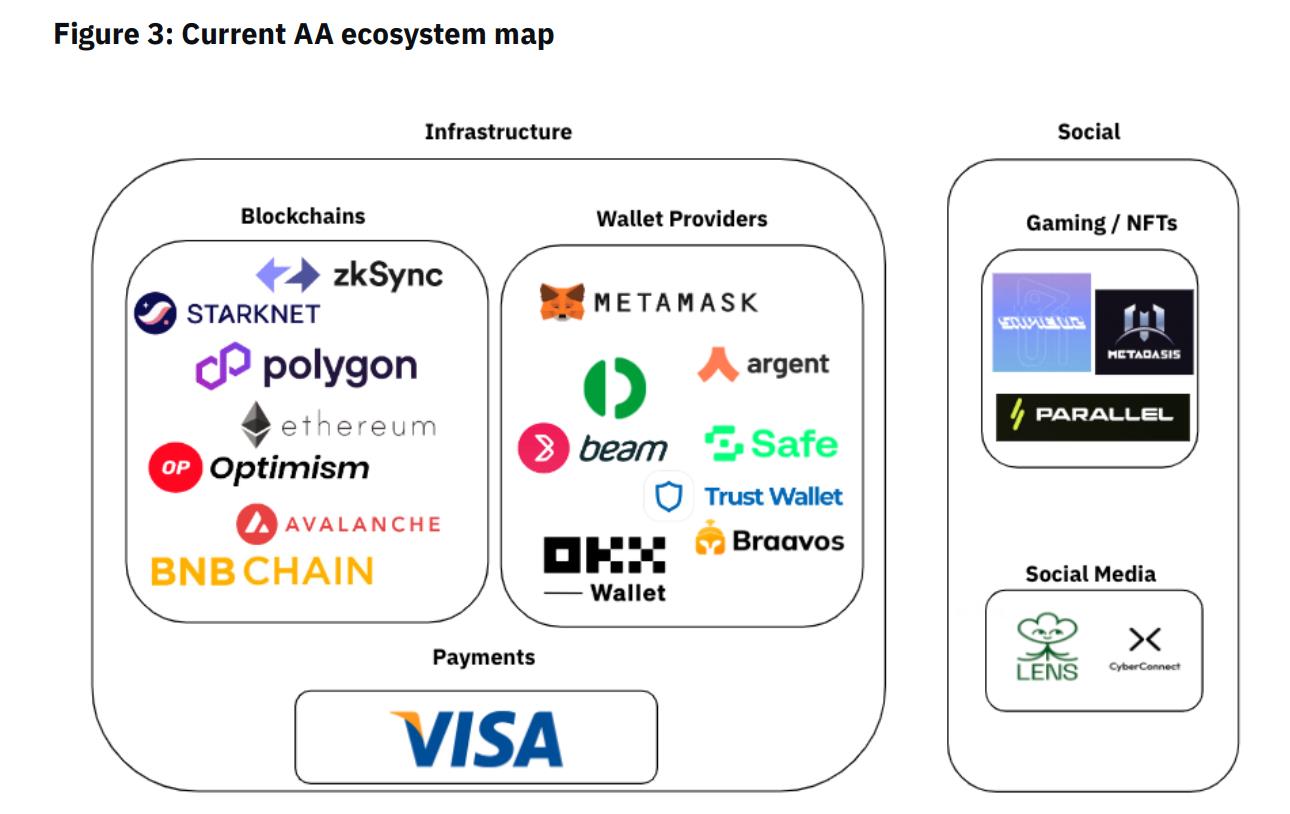
Participating roles in the Infrastructure field:
- Blockchain: EVM-compatible blockchains and zk-rollup scaling solutions that support AA.
- Wallet providers: Wallets that utilize AA to provide specific functionalities to users.
- Payments: The LianGuaiymaster contract provides fee abstraction capabilities, allowing users to execute digital transactions without owning the native tokens of the blockchain.
Participating roles in the Social field:
- Games/NFTs: Adopting AA and token standards such as ERC-4337 and ERC-6551 to improve on-chain gaming experiences and expand the utility of NFTs.
- Social media: Combining AA forms such as signature abstraction to allow users to interact with social networks using Web3 wallets continuously.
Acceptance of AA in the Market
- Key: The ERC-4337 EntryPoint contract was officially deployed on March 1st this year. Since then, there has been a significant increase in transaction activities and the total number of ERC-4337 smart accounts, especially in July.
- The number of smart accounts has been steadily increasing, with nearly 300,000 accounts created in July, corresponding to a sharp increase in user operations.
- Most AA activities are driven by Polygon. This is due to the launch of the social network CyberConnect, where all accounts are ERC-4337 wallets.
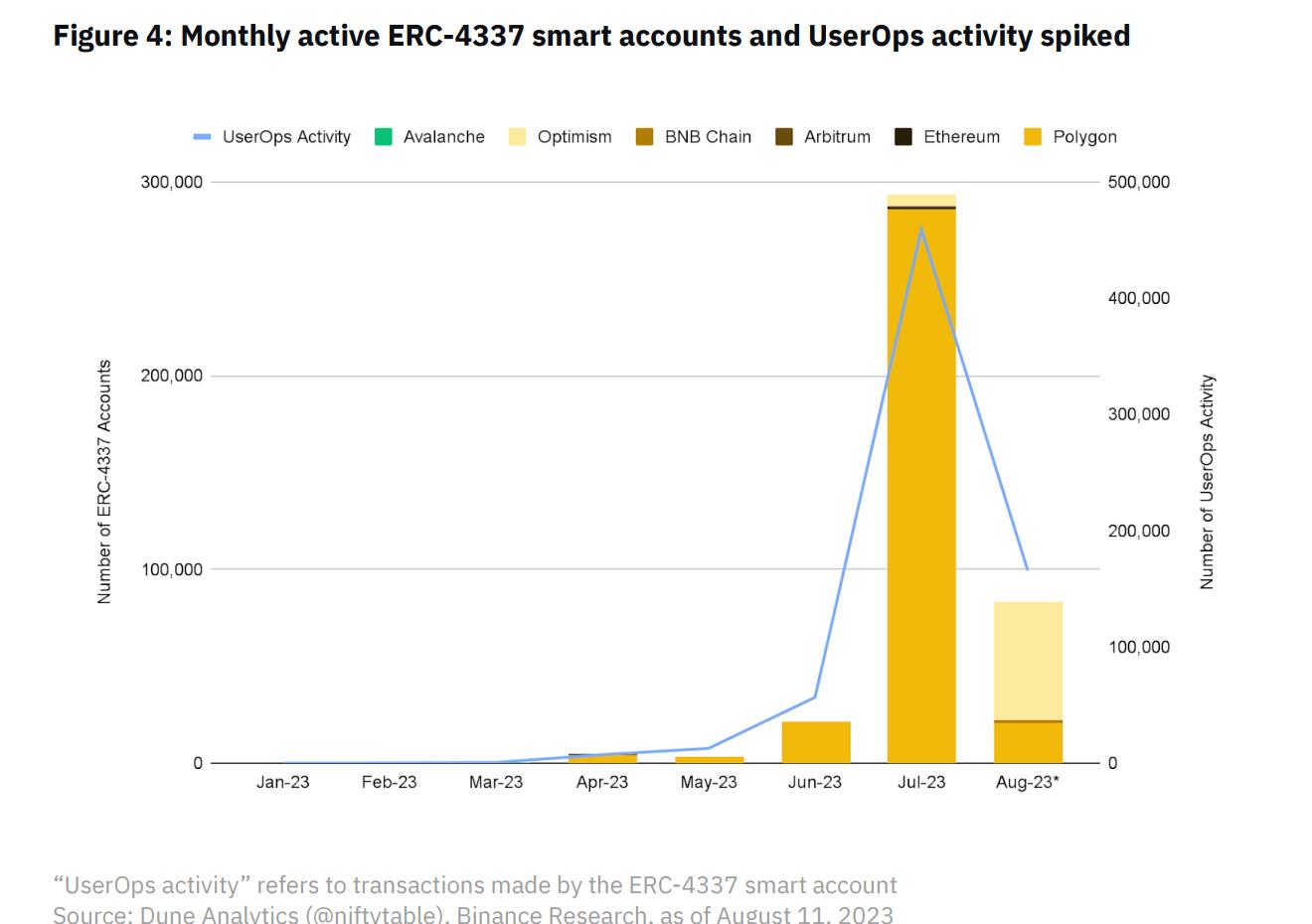
List of AA Use Cases
To understand the use cases of AA, the report focuses on key infrastructure projects that implement token standards such as ERC-4337 and ERC-6551 to introduce new functionalities. These projects aim to improve the UX for end-users and drive the practical adoption of blockchain technology.
Payment Use Case based on LianGuaiymaster
- LianGuaiymaster is a component of ERC-4337 and can be understood as an intermediary that can receive tokens used by users and exchange them for native blockchain tokens to pay for transaction fees.
- Some relevant examples include:
- VISA: Visa showcases a solution that utilizes the LianGuaiymaster contract to abstract basic blockchain interactions and improve the on-chain user payment experience through a self-custodial smart contract wallet. Currently, this case is still in the proof-of-concept stage but aims to reduce friction for users conducting transactions through their wallets. Users can use any token as gas fees, and the gas costs are covered by LianGuaiymaster, exploring the “untapped potential” of digital transactions for consumers.
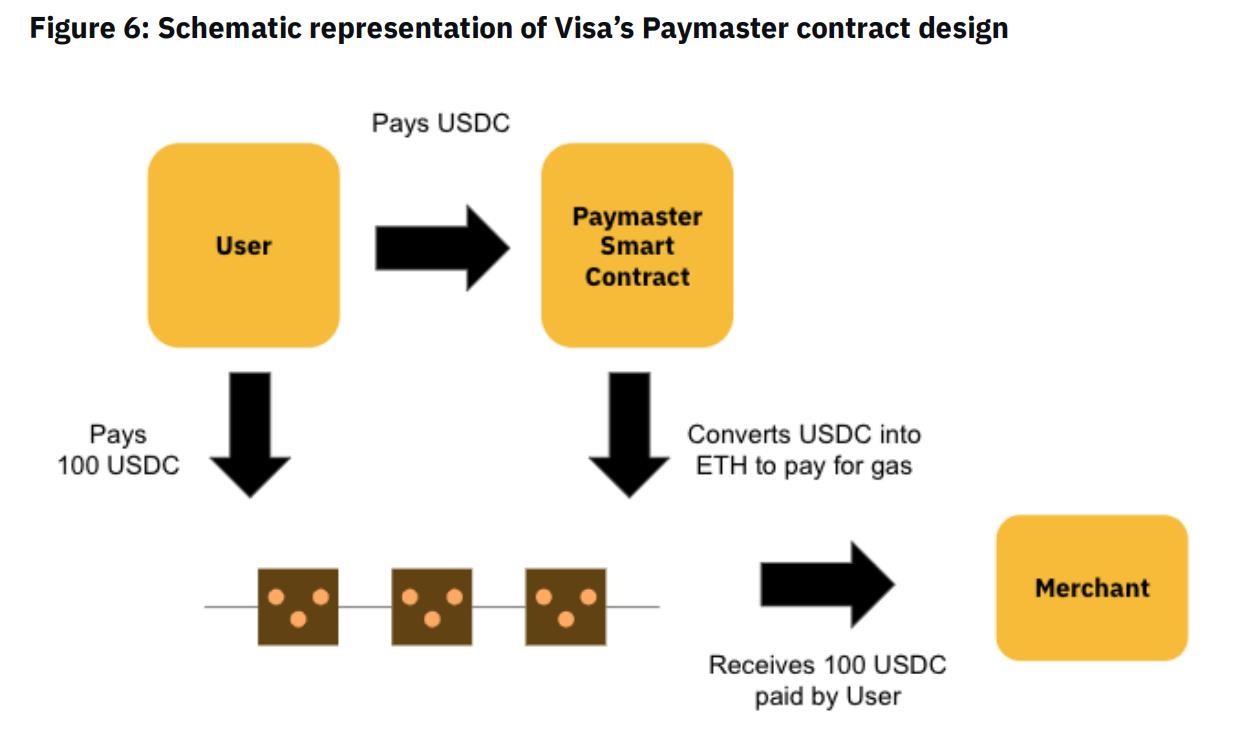
- In addition, VISA has other initiatives to allow users to pay gas fees with Visa cards.
- Other use cases of the LianGuaiymaster contract:
- Overall steady growth, led by Optimism. This is related to the launch of the Beam wallet on OP at the end of July, which allows users to pay transaction fees with the coins used in the transfer, without using the native tokens of the blockchain.
- In the figure below, the total gas volume of the LianGuaiymaster contract has increased significantly, indicating growing demand for these intermediary services to simplify the user experience.

Use cases for wallet management
- By integrating AA into existing wallet solutions, these accounts are enhanced into smart contract wallets with programmable logic, providing new features such as batch transactions and social recovery.
- The following wallet management solutions support AA:
- Safe:

- Introduced a multi-signature scheme that requires multiple authorized entities to sign for the same account instead of separate private keys.
- Recently integrated the ERC-4337 standard through pluggable interfaces, providing modules for developers to build and create wallets.
- Introduced signature abstraction, allowing users to customize the rules for authorizing wallet-initiated transactions according to their preferences. For example, users can specify spending limits to reject transactions of a certain scale in order to prevent suspicious activity.
- Argent:
- Introduced the concept of “social recovery,” allowing users to recover lost or forgotten private keys.
- Users can nominate “guardians,” which are other wallets or accounts they trust, as backups to recover their own wallets.
- Alternatively, users can also use email addresses and phone numbers for offline recovery, introducing familiar two-factor authentication mechanisms.
- Braavos:
- An intelligent wallet launched on Starknet, adopting the form of signature abstraction.
- Users can use biometric features of their phones, such as facial or fingerprint recognition, to access the wallet.
Use cases for delegated transactions
- “Delegatable accounts” utilize AA to allow users to delegate signing authority to an approved external contract. This account contains related rules customized by the user according to their preferences and then interacts with the applications mentioned in the rules without manually approving each transaction.
- VISA’s automatic payment solution:
- While maintaining full control of the wallet, users can approve automated payments for utilities and subscription bills.
- This delegation effectively abstracts signature verification and changes user interaction within the application for a more user-friendly experience.
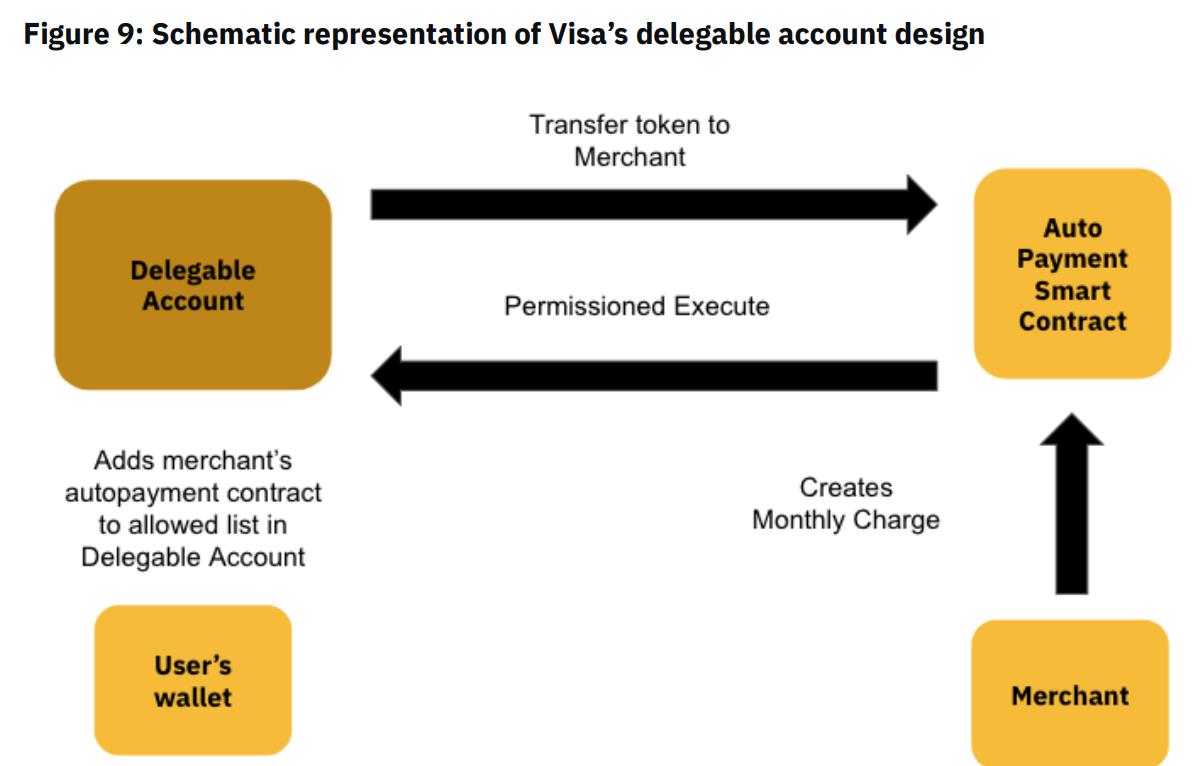
- Social use cases of Lens:

- Allow users to delegate signature permissions to the disLianGuaitcher wallet to perform posting, commenting, and changing personal information;
- Users can interact with dApps continuously without needing approval each time;
- disLianGuaitcher will also pay for the gas fees of these transactions, eliminating the need for users to hold native tokens for in-app interactions;
- This leads to an increase in its usage for a while.
Token-Bound Account Use Case
- ERC-6551 introduces the Ethereum standard for token-bound accounts (TBA), giving NFTs the ability to act as “smart contract accounts” and register themselves as wallets without permission. This enables an integrated mechanism that allows owners to host NFTs in TBAs.
- In the past month, TBA accounts have seen a significant increase:
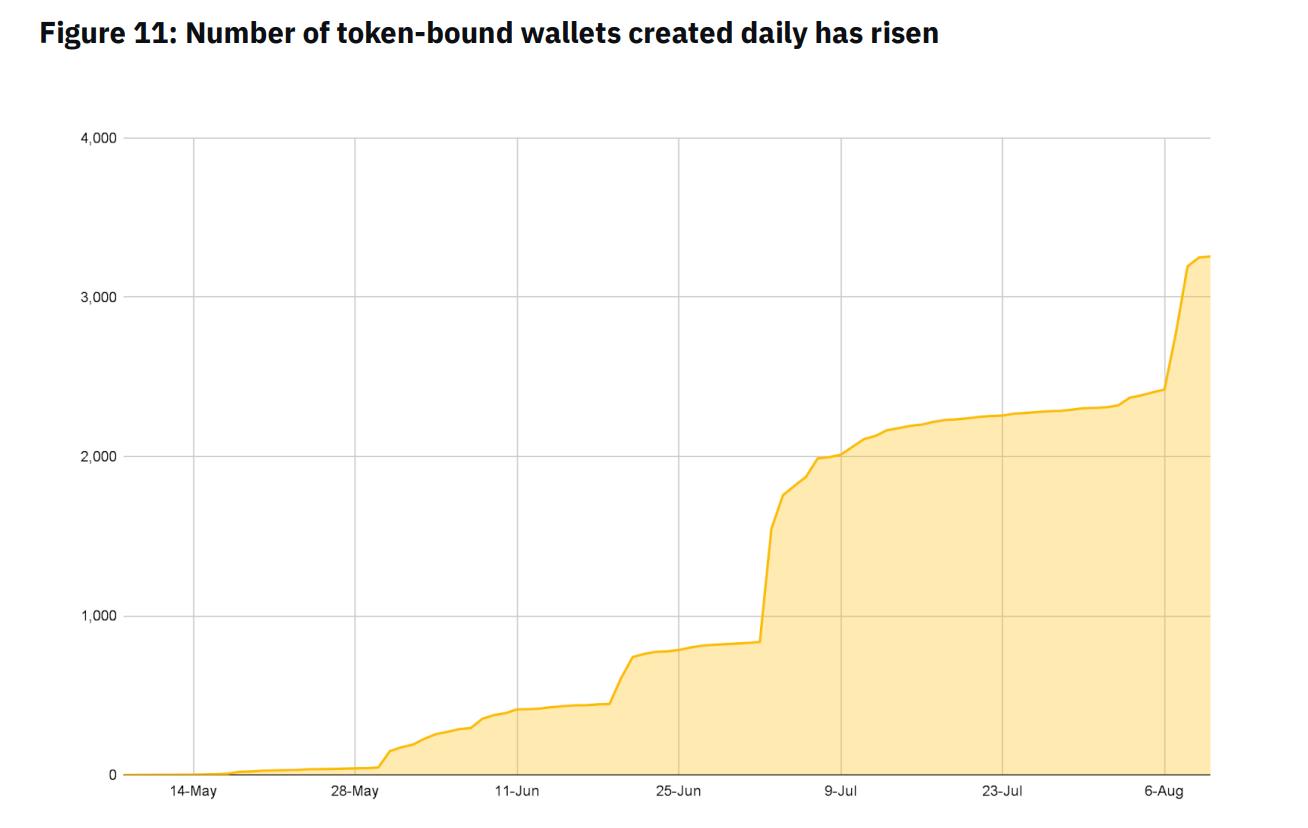
- Through abstraction, it greatly empowers existing NFTs to achieve the following capabilities:
- Enable multi-level ownership of assets
- Enable NFT interoperability between ecosystems
- Reduce gas fees and make transactions more cost-effective
- Allow NFTs to have their own digital identity


- Use case: Sapienz Street Culture
- The Sapienz project brings the ERC-6551 standard to digital street culture.
- Users receive a customizable character that unlocks based on the NFTs they own.
- The “character” is a customizable avatar that represents the user, and users can unlock different appearances of this avatar based on the NFTs they own. They can equip the character with different accessories and personalize it according to their preferences.
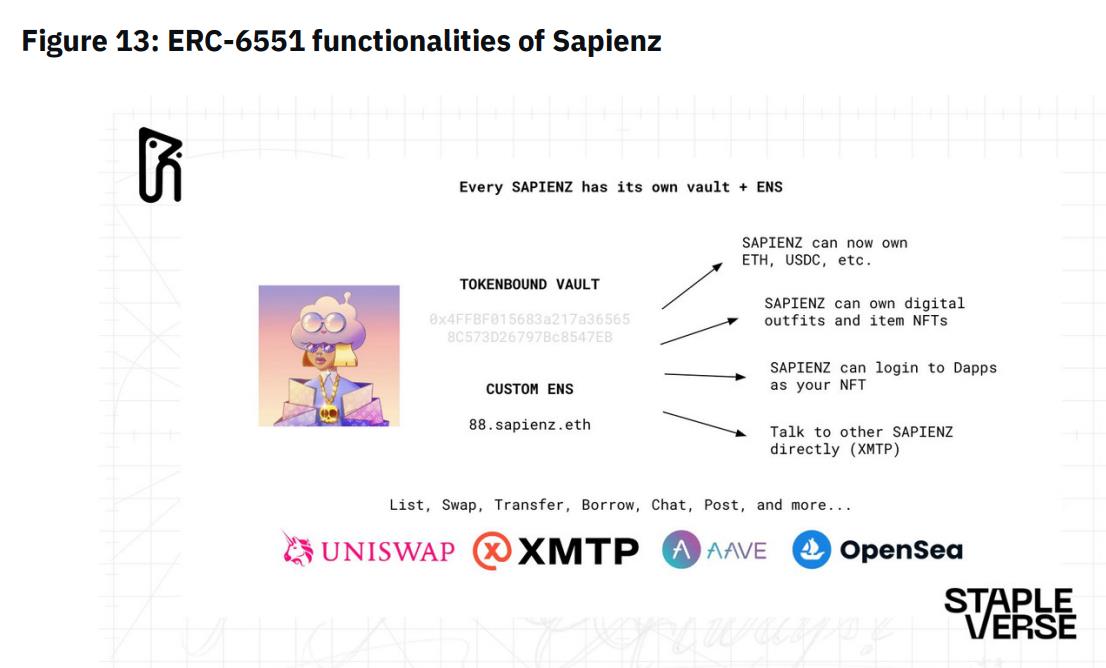
Key Development Points Worth Noting
- Smart contract wallets currently rely on “relayers” operated by intermediaries to convert user-signed messages into typical Ethereum transactions.
- Thus, new L2 chains serve as alternative solutions for developers to experiment with AA, such as:
- zkSync is the first EVM-compatible chain to implement native AA at the protocol level.
- Similarly, the zk-rollup solution StarkNet also implements AA.
- Optimistic rollups like Optimism and Coinbase’s Base also implement AA.
- Proposals and protocols related to AA:
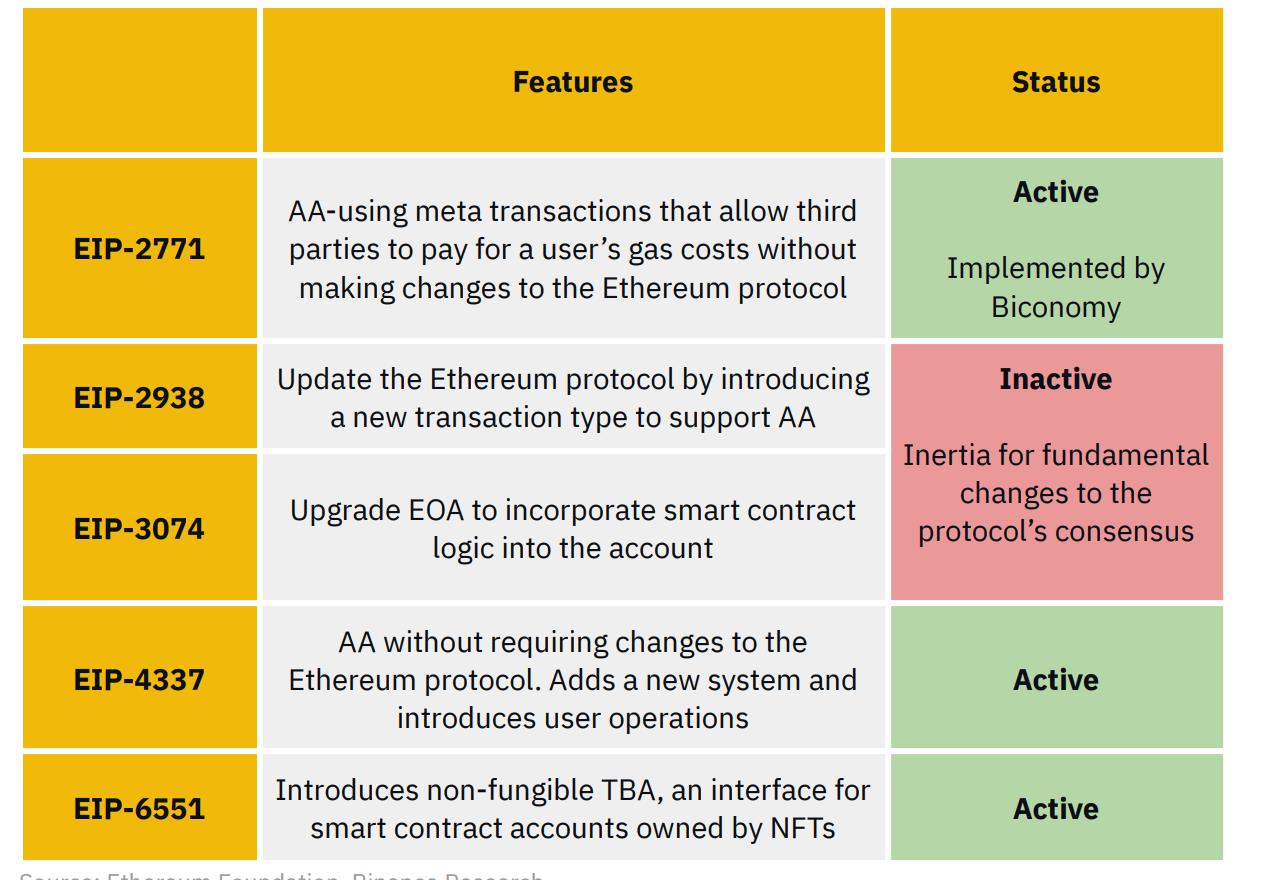
- A timeline of key events from the proposal to the current adoption of AA in the past six months:

Like what you're reading? Subscribe to our top stories.
We will continue to update Gambling Chain; if you have any questions or suggestions, please contact us!